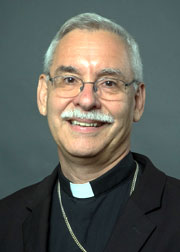Official Website of the
Catholic Diocese of Little Rock
19th Sunday in Ordinary Time, Year B, 2024
Published: August 10, 2024
Bishop Anthony B. Taylor preached the following homily during a Mass for seminarians and their parents at the Cathedral of St. Andrew in Little Rock on Saturday, Aug. 10, 2024.

Bishop Taylor
Geometry is the study of shapes, and the most complex basic shape is the spiral, which has length, breadth and depth but is the only three-dimensional shape without area.
The spiral loops back on itself like a circle but moves forward like a line. Each time a spiral retraces its path, it passes over the same points, but always on a different plane.
In the bread of life discourse, which we are reading section by section this month, Jesus’ speech spirals, loops back to touch on points previously discussed, but always on progressively higher levels — and this can be confusing.
The Bible says that no human can see God and still live. Jesus can see God because he is God, but since Jesus is also human, you and I can look at Jesus — and thus, in that way, see God and still live. Indeed, instead of dying because we see God, we receive eternal life because we see him in Jesus.
You and I are used to linear arguments and logical analysis, deductive reasoning. If A>B and B>C, then A>C. But a spiral argument is alien to us. The only place most of us ever come in contact with spiral arguments is in the Gospel of John.
In today’s Gospel, Jesus spirals back to revisit three points he made in last Sunday’s Gospel, but as he loops back, he does so on a higher plane and thus moves the discussion forward. What last week were his responses to misunderstandings have now become replies to objections. Last week, Jesus introduced people to new thoughts. This week, he begins to defend those thoughts.
The first new thought had to do with spiritual thinking vs. earthly thinking. The person not capable of spiritual thinking will never catch on to what Jesus is trying to say. The issue last week was spiritual bread vs. earthly bread.
This week, the issue is Jesus as the source of that spiritual bread: a spiritual understanding of his origin and identity vs. an earthly understanding of who Jesus is. People object that they know his parents, so how can he claim to have come down from heaven? They know his family, and so jump to natural conclusions about his origin. You and I know the truth of Jesus’ divine origin: God took on flesh and was born of a virgin. But Jesus’ original hearers were not yet ready for spiritual truths of this magnitude.
The second new thought from last week had to do with not just believing Jesus, but also believing in Jesus. And here, Jesus describes faith as a gift, and if you’re not open to this gift, you won’t accept it even when God offers it. No one comes to Jesus unless the Father draws him. Here, Jesus makes an interesting distinction between hearing and seeing.
Believers hear the Father, learn from him and come to Jesus. But only Jesus has seen the Father. The Bible says that no human can see God and still live. Jesus can see God because he is God, but since Jesus is also human, you and I can look at Jesus — and thus, in that way, see God and still live. Indeed, instead of dying because we see God, we receive eternal life because we see him in Jesus.
The third thought from last week had to do with Jesus as the true manna from heaven. Not only does he give this heavenly bread, but he is that heavenly bread. He is the Bread of Life that satisfies every hunger forever. In today’s Gospel, Jesus clarifies that the bread that he will give is his flesh, given for the life of the world. God fed the Hebrews manna in the desert, but they all eventually died.
Like anything material, manna was made of elements that decompose, so the life received by eating it was material, temporary and mortal. It sustained earthly life for a short time. By contrast, the heavenly bread of life is not a thing, but rather a person: Jesus. And since Jesus is divine and immortal, the life we receive by eating him is divine and immortal. The Eucharist gives and sustains eternal life forever.
Today, Jesus spirals back to re-emphasize the points he made last week and, in the process, moves the discussion forward to a higher level of spiritual thinking about who he is, what faith in him involves and his gift to us of the bread of life: his flesh for the life of the world.
In next week’s Gospel we will see that as this discourse continues to spiral forward, so also do the objections of Jesus’ adversaries. Their big objection next week will be: “How can he give us his flesh to eat?” You and I know the answer: The Eucharist, Jesus’ real body and blood — for our life and the life of the world.









